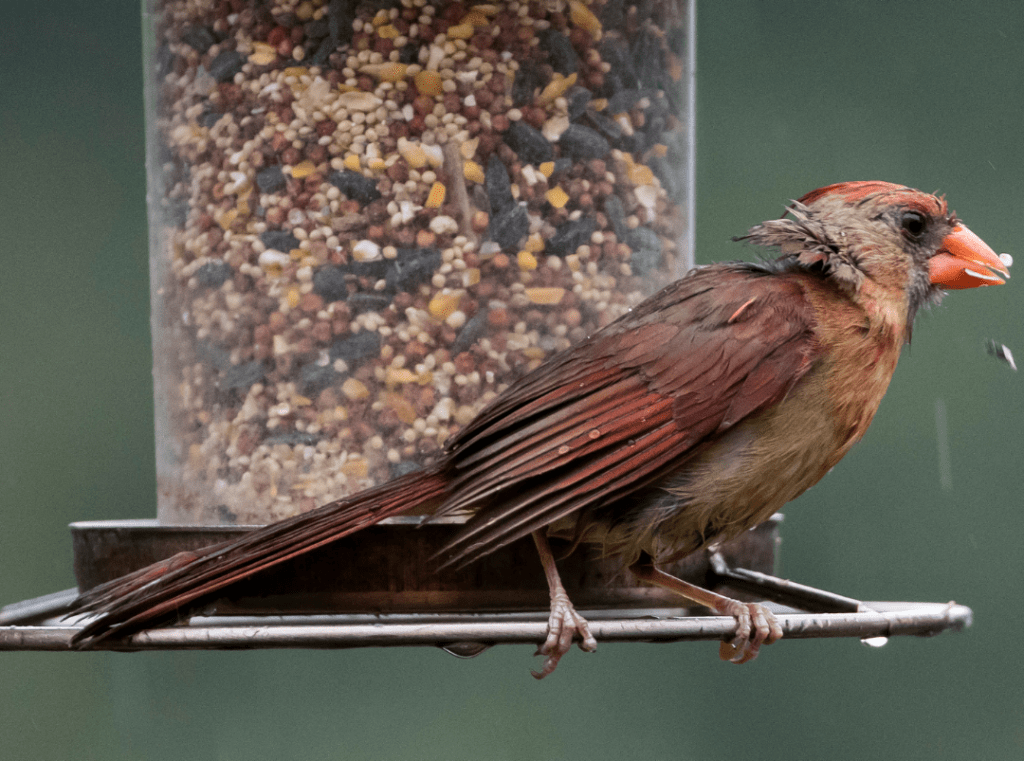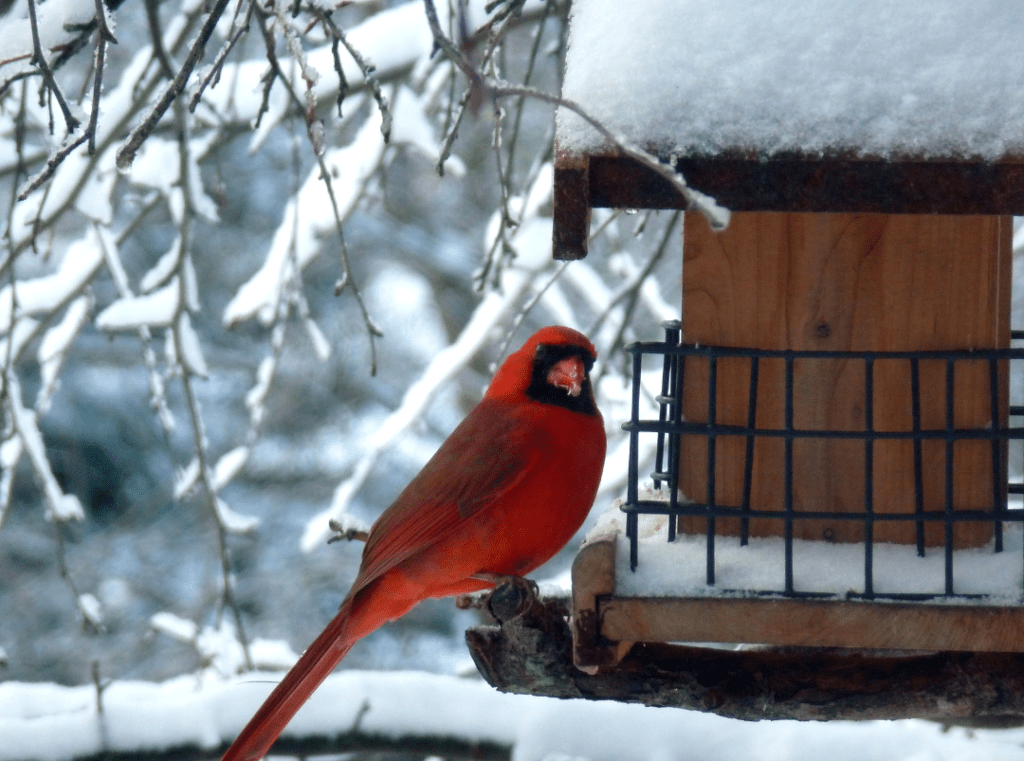Cardinals are one of the most beautiful and beloved birds in North America. Their brilliant red plumage and cheerful songs make them a staple in many bird enthusiasts’ backyard habitats. If you’re looking to attract cardinals to your backyard, it’s essential to understand what they eat. This guide will take you through the cardinal’s diet, both in the wild and in your backyard, to help you provide the right food and habitat for these stunning birds.

Cardinal Diet in the Wild
In the wild, cardinals feed on a variety of foods including seeds, berries, insects, and fruit. They forage for food using their strong beaks and feet, searching for food in trees and bushes. Insects and invertebrates make up a significant portion of the cardinal’s diet, particularly during the breeding season when the high protein content of these foods is essential for maintaining the health of their young. Cardinals also enjoy fruit, particularly during the autumn months when they’re fattening up for winter. Finally, they feed on a variety of seeds, including sunflower, safflower, and millet.
Cardinals are opportunistic feeders and will take advantage of any available food sources. In the winter, when food is scarcer, cardinals rely on conifer seeds, dried fruits, and sunflower seeds. Bird enthusiasts can help support cardinals during these difficult months by providing food and water in their backyard habitats.
What Bugs do Cardinals Eat?
Insects and invertebrates play an important role in the cardinal’s diet, particularly during the breeding season. Cardinals eat a variety of insects, including caterpillars, beetles, and grasshoppers. To attract insects to your backyard, you can provide a variety of plants that support the lifecycle of these insects, such as flowering shrubs, herbs, and weeds. You can also install a bird bath, which will attract not only cardinals but also the insects they feed on.
- Caterpillars
- Beetles
- Grasshoppers
- Moths
- Ants
- Spiders
- Crickets
- Aphids
- Wasps
- Bees
Insects are an important part of a cardinal’s diet, especially for baby cardinals who require a higher protein diet for growth and development. Providing a birdhouse and a safe and suitable habitat in your backyard can help attract insects, which in turn can attract cardinals. Additionally, offering live mealworms can be an excellent way to supplement the insects in the environment and provide a reliable food source for the birds.
What Seeds do Cardinals Eat?
Seeds are an important food source for cardinals all year round. In the wild, they feed on sunflower, safflower, and millet seeds. In your backyard, you can provide a variety of seeds in a bird feeder, such as black oil sunflower seeds, which are particularly favored by cardinals. To ensure that your backyard is attractive to cardinals, it’s important to provide a variety of seeds and to change the seed mix regularly.
- Black oil sunflower seeds
- Nyjer (thistle) seeds
- Millet seeds
- Safflower seeds
- Cracked corn
- Peanut pieces
- Hulled sunflower seeds
- Buckwheat seeds
- Striped sunflower seeds
- Dried fruits such as raisins and cranberries
It’s important to note that different cardinals may have varying preferences for seeds, so offering a variety of seed options can attract a wider range of cardinals to your backyard. Additionally, offering seeds in a bird feeder that is protected from the elements and squirrels can help ensure that the birds have access to food even in harsh weather conditions.
What do Baby Cardinals Eat?
Baby cardinals, or chicks, require a different diet than adult cardinals. During their first few days of life, they are fed a mixture of regurgitated seeds and insects by their parents. As they grow, their diet shifts to a greater proportion of insects and less seeds. This is because the high protein content of insects is essential for the growth and development of the chicks. In your backyard, you can support baby cardinals by providing a birdhouse and a variety of food sources, such as live mealworms, that will attract insects for the parents to feed to the chicks.
- Caterpillars
- Beetles
- Grasshoppers
- Moths
- Ants
- Black oil sunflower seeds
- Millet seeds
- Safflower seeds
- Regurgitated seeds and insects from their parents
It’s important to note that baby cardinals require a higher protein diet to support their growth and development, so providing a source of live insects can be especially beneficial for their health.
What do Cardinals Eat in the Winter?
In the winter, cardinals face challenges in finding enough food to survive. To help support these birds during this difficult time, it’s essential to provide food and water in your backyard. Suet cakes, dried fruit, and sunflower seeds are all great options for winter bird feeding. In addition, you can install bird feeders that are designed to keep food from freezing, such as heated bird baths. By providing food and water, you can help cardinals survive the harsh winter months and be ready to thrive when spring arrives.

Feeding Cardinals in Your Backyard
Providing food and water in your backyard is one of the easiest and most effective ways to attract cardinals. The best bird feeder for cardinals is one that’s sturdy, easy to clean, and large enough to hold a generous amount of seed. Hopper and tube feeders are particularly suitable for cardinals, as they allow the birds to feed from multiple angles. When choosing a bird feeder, be sure to select one that’s appropriate for the size of your bird population, as larger feeders will attract more birds and require more seed.
Attracting cardinals to your backyard requires more than just a bird feeder. You’ll also need to provide a habitat that’s conducive to their needs. This includes a variety of plants and shrubs that provide food, cover, and nesting sites. You can also install birdhouses, birdbaths, and bird feeders that are specifically designed for cardinals.
It’s important to avoid common mistakes when feeding cardinals. For example, you should avoid using a bird feeder that’s too small, as this can lead to overcrowding and stress. You should also be mindful of where you place your bird feeder, as it should be in a safe location away from predators and other hazards. Additionally, you should clean your bird feeder regularly to prevent the spread of disease.
Conclusion
In conclusion, cardinals are omnivorous birds that feed on a variety of foods, including seeds, insects, and fruit. By providing food and water in your backyard, along with a suitable habitat, you can attract these beautiful birds and support their well-being. Whether you’re a seasoned birdwatcher or just getting started, understanding the cardinal’s diet is an essential step in creating a backyard habitat that these birds will love.

James has always been an avid outdoorsman. Since a kid, he kept a journal of all the different birds and species he saw. Now he wants to share his passion with other birders with Happy Birding!
